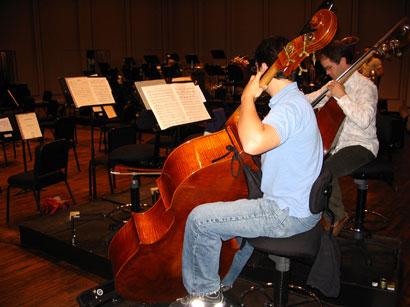Finding a comfortable setup for your instrument can be a struggle for any musician. Each instrument places different stresses on the body, but there are some general things to look for that apply to all string instrumentalists:
- Bridge height: If the bridge is too high it will be harder to press down the strings, especially during fast passages. If you are having pain or fatigue from playing, or notice that you have to work really hard to depress the strings, have your local luthier look at your bridge height and check if it can be lowered. You can also have the fingerboard planed to lower the string height.
- String length: A shorter string length can make it easier to play an instrument, even if two instruments are identical in every other dimension. This is an important feature to consider when deciding between instruments to purchase. If the distance between the peg box and the bridge is longer, you will have to spread your fingers farther apart to play the same intervals. Even a few centimeters can make a difference.
- Size & Shape of the bouts of the instrument: make sure you can move into higher positions on the instrument without too much difficulty. If the upper bouts are too wide, this will be much more challenging. Sometimes instruments can be made with proportionally larger lower bouts, so you can achieve the same rich tone without having wide upper bouts on the instrument that are hard to maneuver around.
- Playability: If your instrument and bow make it easy to make music, you won’t have to work as hard to play. Sometimes a new bow, a fresh bow re-hair, or even a different type of rosin can make a big difference!
- Bow weight: If you are using a heavy bow, especially one that has a heavy tip, it will be much more difficult to play for longer periods of time without fatiguing. A slightly lighter bow is much easier to use for fast passages and difficult bow strokes!
- Chair height & design: It is important that the chair your using for practicing or rehearsals is comfortable and at the right height. Make sure your feet are flat on the floor, with your knees and hips at about 90 degrees. Having a comfortable chair that supports good posture may help decrease back pain during long periods of playing.
Cellists:
In addition to the tips above, if you are a cellist, make sure your endpin is at the right height, and that you don’t have to turn your head too much to see your music stand. The best music stand height is usually right below eye level, so that you don’t have to tilt your head back to read the music. Having a chair at the right height is especially important for cellists, since they have one of the highest rates of back pain among musicians. If you have back pain while you play, consider using back support, especially for long rehearsals. Lumbar support cushions and foam wedges can be used to adapt a regular chair to your needs. Wooden blocks can also be used to raise the height of a chair.

Bass section of Naples Philharmonic Orchestra with ‘concert’ basso (http://www.concertdesign.com/albumbass.html)
Bassists:
In addition to endpin height and the positioning of the music stand, there are a number of other concerns specific to bass players:
- Standing vs. Seated: One of the most debated issues for bass players is to sit or stand while playing. The main arguments for each have been covered by Jason Heath on his Double Bass Blog, but it is ultimately a decision that must be made by each individual player.
- Stool type & height: There are basic stools as well as the more expensive varieties that are fully adjustable (and well worth the investment if you find the right fit!). One example is Concert Design, a Canadian-based company which offers a number of highly adjustable models. You can also find various bass stool designs in music shops and online catalogues. Make sure that the stool will allow you to be in a comfortable playing position, while also providing you with foot support if your feet don’t touch the ground.
- Like other string players, make sure your bow is well-balanced and a manageable weight. Bass bows are heavier to begin with – don’t make it any harder by choosing a bow that is weighted more towards the tip.
Violinists & Violists – don’t worry! Your setup concerns will be addressed in Part 2 of “Finding the Perfect Setup”. Check back next week to find out all about custom chinrests and other setup issues unique to upper string players!















What is the difference between Computer Engineering and Computer Science?